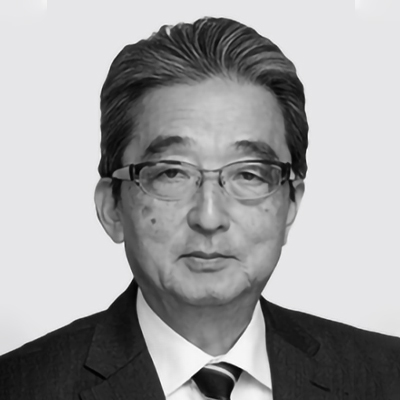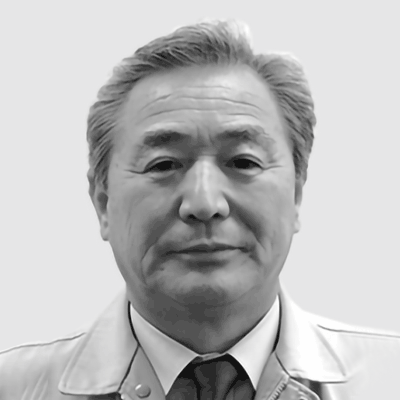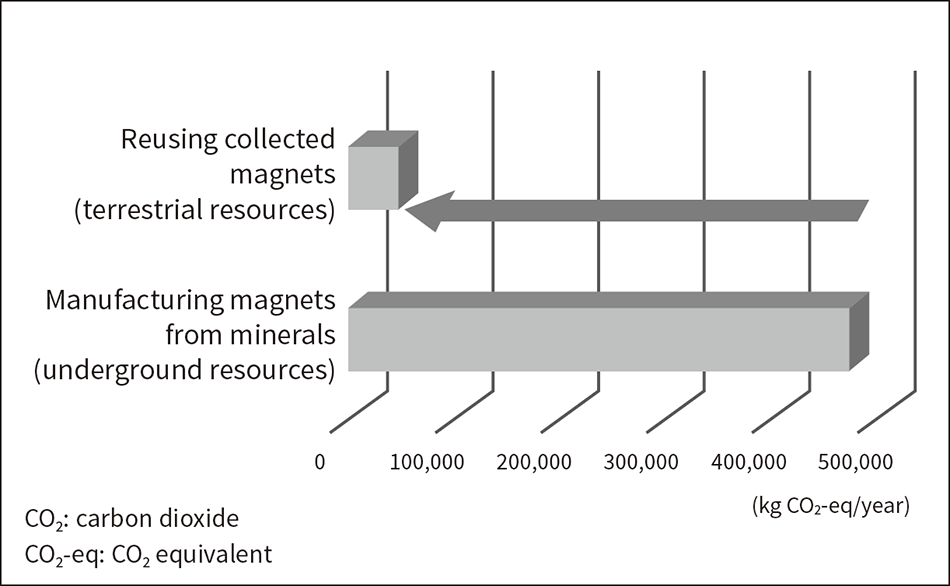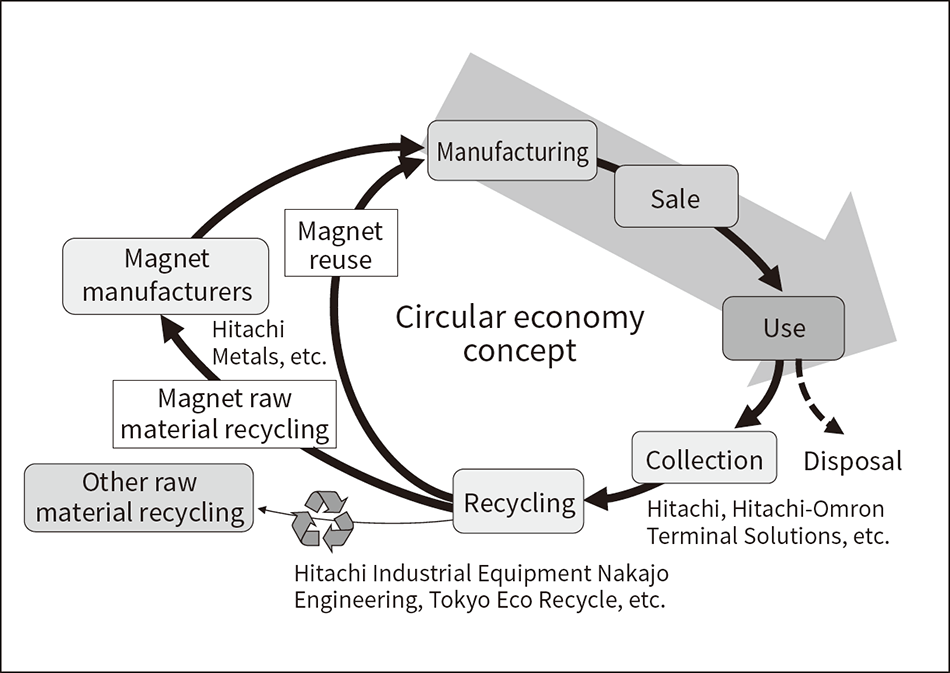Work on Resource Recycling in Hitachi
Responsible Consumption and Production is Goal 12 of the 17 SDGs put forth by the United Nations. Hitachi is focusing on this area by promoting product recycling and effective use of depleted resources (resource recycling) as a way to fulfill its CSR obligations. Under Japan’s Act on the Promotion of Effective Utilization of Resources, Hitachi’s IT electronics business unit is using the National Permit System for industrial waste created by the Ministry of the Environment to collect used products throughout Japan and promote recycling and reuse of resources. Since products with hard disk drives are common among IT electronics, they are managed carefully to prevent information leakage before destruction. They are then recycled as resources within the group, along with the neodymium and other rare-earth metals contained in the drives. This article looks at Hitachi’s recycling scheme and recycling technology, primarily for IT electronics as ATMs.





Figure 1 — Minable Years of Major Resources* The majority of resources have declined in minable years relative to estimates from 10 years ago. Copper’s minable years figure has increased since survey data from 10 years ago shows that copper’s proven reserves have increased, but annual production (consumption) has grown by 30 to 40% over that period.
The majority of resources have declined in minable years relative to estimates from 10 years ago. Copper’s minable years figure has increased since survey data from 10 years ago shows that copper’s proven reserves have increased, but annual production (consumption) has grown by 30 to 40% over that period.
While underground resources such as oil and minerals are crucial manufacturing inputs, they also come with procurement risks such as higher prices caused by the greater resource consumption that accompanies global economic growth (see Figure 1)(1). Located in a country having limited underground resources, Japan’s manufacturers are heavily impacted by stagnating imports of raw materials such as plastic, or base metals such as iron and copper.
Hitachi has been stepping up its work on resource recycling in response to Japanese laws that went into effect around 2000, such as the Act on Recycling of Specified Kinds of Home Appliances (‘Home Appliance Recycling Act’) and the Basic Act on Establishing a Sound Material-Cycle Society. Specifically, the company is focusing on voluntary IT electronics collection and resource recycling by using the Ministry of the Environment’s (MOE’s) National Permit System(2), *1, which was created by an amendment to the Waste Management and Public Cleansing Law (2003). The hard disk drives frequently found in IT electronics contain rare-earth elements such as neodymium. While each drive only contains a few grams of these substances, the company efficiently collects and recycles them as resources.
Neodymium, dysprosium, and other rare-earth elements are going to be important resources for meeting the needs of the mobility society and energy-saving and resource-saving society of the future. Since underground resources are distributed unevenly throughout the world, factors such as resource nationalism and speculation still pose challenges for ensuring a stable supply of these resources. In 2008, Hitachi addressed this issue by starting to sort and collect rare-earth magnets from used products. The magnets are recycled and used to replace some of the conventional raw materials used in the magnet manufacturing processes of magnet manufacturers. These efforts received official recognition in 2018 when Hitachi Industrial Equipment Nakajo Engineering Co., Ltd. and Tokyo Eco Recycle Co., Ltd. shared the Ministry of Economy, Trade and Industry (METI) Minister’s Prize category of the FY2018 3Rs (Reduce, Reuse, and Recycle) Awards.
The next section looks at the IT equipment collection scheme and recycling technology that the prize was awarded for.
To fulfill its corporate social responsibility (CSR) obligations, Hitachi meticulously collects and recycles used products to promote resource recycling and reuse. The work of product collection is done by an organization called the Product Recycling Service Center(2) that has been created within the Environment Policy Division of Hitachi’s Systems & Services Business Division (see Figure 2).
To enable Hitachi and 16 affiliates to handle about 100 different product types throughout Japan, the scheme is being run by members who have obtained certification under the MOE’s National Permit System for industrial waste. A total of about 500 metric tons of automated teller machines (ATMs), servers and other products have been handled in the five years from 2014 to 2018, with hard disk drives accounting for about 10 metric tons (or about 20,000 drives).
Use of the scheme is enabling a unified approach to the collection of used products, including products of the affiliates themselves. As a result, it covers the majority of the Hitachi’s IT electronics, has expanded client needs, and has reduced the waste management workload arising when assets are disposed of. As shown in Figure 3, the company has created a safe and worry-free waste solution that can provide a consistent level of service everywhere by creating a nationwide collection/recycling network and standardizing the method of tracing useful resources and waste after sorting. Waste tracing is done in a client-oriented manner, with conscientious auditing of outsourced contractors and secondary contractors.
Figure 2 — Functions of Hitachi’s Product Recycling Service Center To promote a sustainable society, Hitachi’s Product Recycling Service Center collects used Hitachi products, and processes them using methods that have been standardized throughout Japan (including security management and recycling procedures).
To promote a sustainable society, Hitachi’s Product Recycling Service Center collects used Hitachi products, and processes them using methods that have been standardized throughout Japan (including security management and recycling procedures).
Figure 4 — Number of ATMs Collected and Recycled (Top), Equipment Being Stored and Inspected (Bottom) The graph shows the number of ATMs collected by Hitachi-Omron Terminal Solutions, Corp. since it began its voluntary collection activities in 2007. The data for 2014 and after also includes ATMs collected through Hitachi’s voluntary collection activities. The collected ATMs are arranged and stored by model and year, then sequentially disassembled by hand. Hitachi obtains information about the parts to extract by contacting Hitachi-Omron Terminal Solutions beforehand.
The graph shows the number of ATMs collected by Hitachi-Omron Terminal Solutions, Corp. since it began its voluntary collection activities in 2007. The data for 2014 and after also includes ATMs collected through Hitachi’s voluntary collection activities. The collected ATMs are arranged and stored by model and year, then sequentially disassembled by hand. Hitachi obtains information about the parts to extract by contacting Hitachi-Omron Terminal Solutions beforehand.
Since ATMs are IT electronics that demand high security, sharing information with the manufacturer (Hitachi-Omron Terminal Solutions, Corp., HOTS) is important. Hitachi once manufactured ATMs and similar equipment in Tainai City, Niigata. The local successor to this legacy is Hitachi Industrial Equipment Nakajo Engineering (Nakajo EG), which still retains engineers with in-depth structural knowledge of ATMs. HOTS and Nakajo EG have been working closely together on reuse and recycling work in their respective roles since 2007. Between the units collected via the Hitachi’s National Permit System channels and the units collected independently by HOTS, about 2,000 used ATMs per year have been delivered to Nakajo EG (see Figure 4).
To apply the disassembly method or procedure that is best suited to each unit’s production model year and model, Nakajo EG sorts the equipment into groups before starting disassembly work. The disassembly work is done by hand to break the equipment down as much as possible into single materials which can then be recycled efficiently into resources. Careful manual disassembly procedures have recently become increasingly important since the work is now being done in a way that will enable parts and other components to be rebuilt by servicing them back to a nearly-new state.
Maintenance parts (parts for reuse) are still currently the main application, and about 20 different part types and a total of about 7,000 parts have been effectively reused to date. Even if the ATMs themselves only have a service life of 10 years due to design upgrades and changing currency designs, some parts are still usable in many cases. Refurbishment and reuse will need to continue being expanded by applying the design for the environment (DfE) approach to product design.
When floods, earthquakes, or other natural disasters strike, maintaining the functionality of the IT electronics that underpins the infrastructure of the modern world is just as important as maintaining conventional lifelines such as the water and power supplies. Water and other damage caused by the Great East Japan Earthquake of 2011 temporarily shut down hundreds of ATMs in banks, post offices, and convenience stores. Parts loans from used products received interest at the time, and at the request of HOTS, Nakajo EG made preparations to enable work on restoring used product parts instead of using new parts that would take longer to supply. The idea of extracting reusable parts from used products and using them to restore damaged products helped speed restoration when it was first applied during a flood in Thailand that same year. Since individual parts have little weight, parts reuse is not very beneficial in terms of resource-saving or reducing the energy used to manufacture new parts, but it has been found to be effective as a backup method during emergencies. This effectiveness comes from the secondary benefits that arise from the idea of parts reuse/refurbishment—the idea that used products can still contain useful parts.
Resource recycling can contribute directly to effective use of limited underground resources. ATMs are constructed mainly from steel materials, and steel makes up about 90% of all collectable parts (see Table 1). With the exception of touch panel glass materials, almost all the other materials in parts such as control boards and cables are of benefit to domestic resource recycling in Japan.
Figure 5 shows a model of the steel resource recycling process. This type of short-loop domestic resource recycling can reduce consumption of iron ore imported from overseas. In terms of the life cycle assessment (LCA) calculation, it also reduces energy consumption to about one-third the level required to produce steel from iron ore. These benefits make steel a model resource that is crucial for creating a highly developed circular economy(3).
Other materials used in ATMs include copper, aluminum, and plastics, but not all of them enable the same degree of effective reuse as steel. For example, plastics are mainly recycled by using the heat produced from burning plastics or using burnt plastic ash in aggregates. While these uses may meet the strict definition of recycling, they represent the one-way recycling of a linear economy. The plastics used in ATMs have a recycling rate [= (Quantity of Valuables + Quantity of Recyclables) ÷ (Processed Quantity)] of 99%, but more awareness of circular economies and resource recycling work that promotes more circularity are going to be needed in future.
Table 1 — Example ATM Composition The recycling rate is given by (Weight of Valuables + Weight of Recyclables) ÷ (Total Weight).
The recycling rate is given by (Weight of Valuables + Weight of Recyclables) ÷ (Total Weight).
Figure 5 — Steel Resource Recycling Process For a country poor in natural resources like Japan, resource recycling is an effective means of reducing resource consumption.
For a country poor in natural resources like Japan, resource recycling is an effective means of reducing resource consumption.
All the hard disk drives collected from ATMs and other IT electronics by Hitachi Group members in Japan are collected by Tokyo Eco Recycle and recycled en masse. Hard disk drives are also collected from PCs and other IT electronics discarded from Hitachi business sites in collaboration with Nichiwa Service, Ltd., the company that handles the environmental management work of Hitachi manufacturing sites. Nichiwa Service has centers in Ibaraki and Kanagawa prefectures, where several Hitachi business sites are located. As part of its community welfare recycling work, it works with local community welfare centers and employs mentally handicapped workers to disassemble collected PCs. The company began operating in FY2013, and has gathered 100,000 hard disk drives per year from collection centers throughout Japan in the 6 years since.
Cost and quality are the most important considerations when recycling hard disk drives. When hard disk drives are manually disassembled into the parts shown in Figure 6 (left), a single worker can only process about 10 to 12 drives per hour. However, an automatic hard disk drive disassembler developed by Hitachi between 2009 and 2011 with a grant from METI and the New Energy and Industrial Technology Development Organization (NEDO) has now increased the efficiency of this work, enabling Tokyo Eco Recycle to process about 140 drives per worker per hour(4).
The disassembler works by exploiting the properties of the screw-fastened construction of hard disk drives. It subjects the drive to impacts and vibrations that loosen the screws, automatically disassembling the drive into its component parts. As shown in Figure 6 (right), the disassembler was set to the shock strength and vibration frequency combination most successful for disassembly. Its primary feature are the through-holes used to prevent the sintered rare-earth magnets from being pulverized when impacts are applied (see Figure 7). Providing these through-holes creates a way to selectively collect magnets that have separated from the drive.
Magnets that get damaged and pulverized create the risk of subsequent magnet refurbishment processes being affected by spontaneous combustion hazards or contaminant infiltration, but selective collection via the through-holes enables magnets to be collected without damaging them, keeping them nearly intact.
Figure 6 — Parts Obtained aft er Hard Disk Drive Disassembly Since all their parts are fastened by screws (bolts), hard disk drives can be disassembled by hand (left). Hitachi’s automatic disassembler has over ten times the processing capacity of manual disassembly when equal numbers of parts are processed by each method. The majority of hard disk drive parts remain intact 10 to 20 minutes after the drive is placed in the disassembler. As more time elapses, the screws loosen and the parts start coming off. After 40 minutes, the disassembly success rate is over 95% (right).
Since all their parts are fastened by screws (bolts), hard disk drives can be disassembled by hand (left). Hitachi’s automatic disassembler has over ten times the processing capacity of manual disassembly when equal numbers of parts are processed by each method. The majority of hard disk drive parts remain intact 10 to 20 minutes after the drive is placed in the disassembler. As more time elapses, the screws loosen and the parts start coming off. After 40 minutes, the disassembly success rate is over 95% (right).
Hitachi’s automatic disassembler has been used to collect about 26 metric tons of magnets from hard disk drives over the 6 years since FY2013. When collection of rare-earth magnets for magnetic resonance imaging (MRI) scanners was added in FY2018, the total volume of magnets collected for that year alone was about 25 metric tons. So, in just one year, roughly the same quantity of rare-earth magnets was collected for resource recycling as was collected from hard disk drives over 6 years. Like steel resource recycling, rare-earth element resource recycling helps reduce energy consumption. In turn, this reduced energy consumption helps reduce emissions of CO2, the most detrimental greenhouse gas for global warming. CO2 is emitted during the series of processes involved in resource mining and refining, raw material shipping, domestic transport, and magnet manufacture. Figure 8 shows the CO2 reduction calculated from the inventory data of the LCA software program Multiple Interface Life Cycle Assessment (MiLCA)(5). It shows that one year’s worth of rare-earth magnets (about 25 metric tons) collected by Tokyo Eco Recycle and reused through domestic resource recycling reduces CO2 emissions to less than one-tenth the level that would result from the same weight of rare-earth magnets being manufactured from ore resources.
The rare-earth elements in products such as hard disk drives were previously not collected, wasting a valuable resource. However, by using a recycling scheme and recycling technology created in-house, resource recycling currently provides Hitachi with resources equivalent to about 10% of the rare-earth magnets it procures. The group began the scheme purely as a way to help reduce environmental impact, but since measures such as used product collection and equipment automation later made it possible to recycle rare-earth magnets through the supply chain at a lower cost, it is still currently in use (see Figure 9).
Figure 8 — Calculation of Carbon Dioxide Reduction Enabled by Resource Recycling of Rare-earth Magnets Reusing rare-earth magnets in Japan as terrestrial resources can reduce CO2 generation to one-tenth the level resulting from conventional manufacturing methods.
Reusing rare-earth magnets in Japan as terrestrial resources can reduce CO2 generation to one-tenth the level resulting from conventional manufacturing methods.
Figure 9 — Rare-earth Magnet Resource Recycling Supply Chain Until now, the flow from manufacturing to disposal has been linear. Switching to the use of a circular flow of resources in the future will reduce the disposal quantity, and bring different methods of adding value (such as parts/materials reuse and raw materials recycling) into the supply chain in a well-balanced manner. This circular flow will help prolong product life and save resources, while hopefully creating a highly developed circular economy for better coexistence between man and nature.
Until now, the flow from manufacturing to disposal has been linear. Switching to the use of a circular flow of resources in the future will reduce the disposal quantity, and bring different methods of adding value (such as parts/materials reuse and raw materials recycling) into the supply chain in a well-balanced manner. This circular flow will help prolong product life and save resources, while hopefully creating a highly developed circular economy for better coexistence between man and nature.
In the years ahead, it will be important to expand the range of products included in recycling schemes, recycle a greater variety of parts and materials, and work on reducing environmental impact. It will also be important for the manufacturers of resource-poor Japan to present plans for ongoing sustainability efforts. Expanding the range of recycled products will result in the addition of products that require intricate disassembly work not easily done by hand, and products with disassembly procedures that require accurate position data taken from the design information. The need for the labor-saving technology made possible by the automatic hard disk drive disassembler will likely continue to grow to satisfy safety and quality demands. This technology is already being used to recycle smartphones and other mobile terminals. Hitachi recycles some used mobile terminals using the automatic disassembler with unmanned processes. In the years ahead, it plans to also use technologies such as artificial intelligence (AI) and the Internet of Things (IoT) to help solve labor shortages.
This article has looked at some examples of efficient resource use that are designed for cost-effectiveness and anticipate a shift from the mass resource consumption of today, to the coming era of sustainability and coexistence with nature. These examples are the result of design information-driven collaboration that draws on the strengths of the manufacturer-based ‘venous industry.’*2 Resource recycling is in high demand among material producers, and regional and financial considerations will make outside collaboration (such as with Shin-Etsu Chemical Co., Ltd.) another important element.
The Sustainable Development Goals (SDGs) set forth by the United Nations include ‘Responsible Consumption and Production’ (Goal 12) and ‘Partnerships for the Goals’ (Goal 17). To help make these goals a reality, Hitachi plans to continue practicing efficient resource recycling through both supply chain coordination within Hitachi and partnerships outside the group.
The technology development discussed in this article was made possible by two grant programs—the FY2009 Grant for New Resource Circulation Projects (Developing Technologies for Recycling Rare-earth Elements from High-performance Magnet Motors) awarded by the Ministry of Economy, Trade and Industry (METI), and the 2011 Rare Metal Substitute Materials Development Project (Development of Technology for Removal of Magnets from Products Containing Rare-earth Magnets and Recovery of Rare Earths) awarded by the New Energy and Industrial Technology Development Organization (NEDO). Hitachi activities described in this article were officially recognized by the Waste Reduction, Recycling Sectional Meeting of the Niigata Environment Meeting, who awarded it their 2017 Niigata Prefecture Excellence Recycling Establishment Commendation. These activities also received a recommendation from Niigata Prefecture the following year, and won the METI Minister’s Prize category of the FY2018 3Rs (Reduce, Reuse, and Recycle) Awards. The authors would like to express their heartfelt appreciation to everyone involved.